#nalakubara
Note
I understand that there are many versions of Nezha and we shouldn't stick to just one version, but I wanted to ask, does Nezha's age vary in any of the stories?
Hello!
Put very bluntly, yes, Nezha’s age varies depending on which story you’re reading and who’s retold it.
I happened to stumble upon a timeline error where Nezha’s brother Muzha is described to be using martial arts weapons referred to as “Hooks of Wu” which were specific to the 1800s, quite a long time after Canonization of the Gods was published, but also originating from a time period where numerous varied editions of that story were in circulation. Upwards of twenty different versions exclusive to the 19th century, actually.
The problem arises that Canonization of the Gods is meant to be occurring during the Zhou Shang conflict, that I will generously assume to be in 1045BCE, centuries before the Hooks of Wu would actually exist. It’s completely possible that the version Gu Zhizhong translated was one of these later editions as is makes no chronological sense for Muzha to have those kinds of weapons to begin with. So I have been on somewhat of a rabbit chase trying to pin down the edition Gu Zhizhong used.
Bearing such errors in mind, it’s easy to see where the confusion of Nezha’s age can come from. Before his origin story was integrated within Canonization of the Gods he would be roughly three to seven days old when his conflict with Ao Guang and the Lady Rock Demoness would occur - whereas within Canonization of the Gods he’s actually 6 or 7 years old.
Outside of that, a definitive age isn’t actually provided. Genuinely, within the scope of Chinese folklore and mythos it’s very rare to assign someone an exact age - which I do believe contributed heavily to the known discourse surrounding Nezha’s age to begin with.
He was imported as an adult from India, a child form not seeming to exist for a while until stories of Krsna were integrated to how the Chinese envisioned Nalakubara. Krsna, being an infantile disguise for the notorious Vishnu, also displays supernatural human strength and is actually successful in killing his father figure (1) — unlike Nezha.
As children, both Krsna and Nezha are able to wield heavenly bows and subjugate water spirits (2) while also being known to be dragon tamers (3). The inclusion of these stories to Nezha predates the sculpting of the Quanzhou Pagoda’s (which have been discussed briefly here) and are arguably the earliest evidence of Nezha being a dragon tamer.
Speculatively a child god combination of both Nalakubara and Krsna named Nana is likely where a majority of Nezha’s child attributes come from, based in the Scripture of the Supreme Secrets of Nana Deva - which would see translations within China during the Northern Song period of 960AD-1127AD. Nana would be described thus:
At that time there was a Deva called Nana. His appearance was exceptionally handsome, and his face beamed with a gentle smile. He was holding the sun, the moon, and various weapons. His numerous treasures and abundant jewelry shone more brightly than the sun and the moon. He made himself a luoye robe (4) from the dragons Nanda and Upananda, and a belt from the dragon Taksaka (5). He possessed the same strength as Narayana (i.e. Visnu). He too came to the assembly and sat down facing the Buddha … At that time the Buddha emanated great light from his dharma body of meditation. The light covered the entire Buddha Universe, reaching all the great evil yaksas, the various types of raksasas and pisacas (6) and all the evil dragons as far as the heavenly constellations. When the Buddhas light shone upon them they all awoke to the truth. The Buddhas light returned to him and, after encircling him three times, entered his head. It then reissued in seven colors from his brow, entering Nana-Deva’s head. When the Buddha light penetrated his head, Nana Deva displayed an enormous body like Mt. Sumeru. His facial expression alternated between terrifying anger and a broad smile. He had a thousand arms, and he was holding a skull (7) and numerous weapons. He was handsomely adorned with a tiger skin robe and skulls. [Mightily Strong] He emanated blazing light and terrifying strength. When Nana Deva displayed this divine body, the great earth shook, and all who beheld him were terrified.
Both Nana and Nezha share the same residence of Vaisravana’s palace, are known dragon tamers, and both were known to use belts. The Supreme Secrets of Nana Deva predate all known connections between Nezha and dragons, perhaps lending to Nezha many more elements than initially believed.
Though without concrete evidence stating one way or another, I can only present this information speculatively - especially as it seems difficult for some to understand that Nezha does enjoy a known adult and child form. This answer has already become quite long, so if there’s still confusion regarding this please feel free to ask for more details.
Bibliography:
(1) Goldman, “Fathers, Sons and Gurus,” pp.350, 364; Masson, “Childhood of Krsna”; Ramanujan, “The Indian ‘Oedipus’”; Silk, Riven by Lust, pp. 164-170.
(2) Harley, “Krishna’s Cosmic Victories”; Matchett, “Taming of Kaliya”.
(3) It’s worth comparing Matchett’s “Taming of Kaliya” p.116 with Canonization of the Gods 12.103. Nezha is five days old within the Ming era Sanjiao yuanliu shengdi fozu sou shen daquan, p. 326.
(4) Luoye is the Chinese term for a garment Indian men tied under the armpit, leaving their right shoulder bare. See Xuanzang, Da Tang Xiyu ji, T. 2087, 51: 876b, and Li Rongxi’s translation, Great Tang Dynasty Record, p.53.
(5) Nanda, Upananda, and Taksaka appear in various Buddhist lists of the eight dragon kings; see Foguang da cidian, pp. 6378,6405.
(6) The rakasas and pisacas are two types of Hindu ogres, who Buddhists demonology incorporated. Both types feed on human flesh. See Foguang da cidian, pp6673-6674 and 3851; Monier-Williams, A Sanskrit-English dictionary, pp. 871 and 628; and Strickman’s survey of Buddhist demonology in his Chinese Magical Medicine, pp. 62-68.
(7) Geboluo appears frequently within the contemporaneous Chinese translation of the Hevajra Tantra (Foshuo dabeikong zhi jin’guang dajiaowang yigui jing), no. 892 volume 18: 587-601.
(8) Zuishang mimi Nana tian jing, no. 1288, 21:358b-c. hi
#nezha#li nezha#lmk nezha#monkie kid nezha#nezha 2019#the legend of nezha#nezha lego monkie kid#third lotus prince#nalakubara#krsna#vishnu#nana deva
40 notes
·
View notes
Text
God form Nezha


-
-
Full pic:

Thoughts: I personally think Nezha’s war/god form would be massive, not to mention in an old depiction of him he’s seen holding the sun and the moon in his hands (that’s why I quoted him being the earth). I feel like his god form would be called “Nalakuvara/Nalakubara” since that’s what he’s referred by in old texts and even mantras. Anyways I had fun sketching this out, I tried to make him more deva like, like in Buddhist depictions. Since this is Lmk Nezha I put some elements of his nickname ”demon child”, giving him tusks like teeth on his right head, I also gave him the headpiece Erlang is seen having in the animated version. Because this is still a sketch this is not the finalized version of my depiction of Nezha’s god form :P
-
-
-
#lego monkie kid#art#digital art#lmk nezha#lmk#painting#monkie kid#nezha#lmk fanart#lego monkie kid nezha#monkie kid nezha#nezha lmk
225 notes
·
View notes
Text
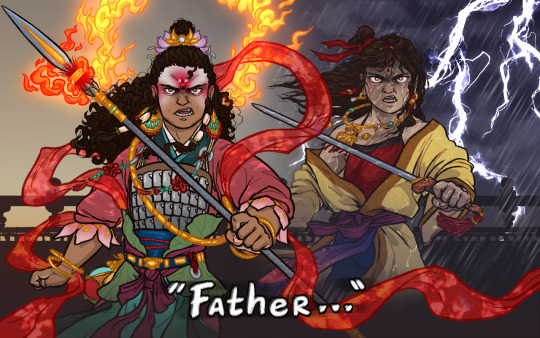
Prodigal son terror
Li Jing in a fury grabbed his halberd, leapt on his horse and galloped out of the headquarters. He was astonished to see Nezha with his Wind-Fire Wheels and Fire-Tipped Spear. He swore loudly, "You damned beast! You caused us endless suffering before your death, and now that you've been reborn, you're troubling us again!"
"Li Jing! I've returned my flesh and bones to you, and there's no longer any relation between us. Why did you smash my golden idol with your whip and burn down my temple? Today I must take my revenge!"
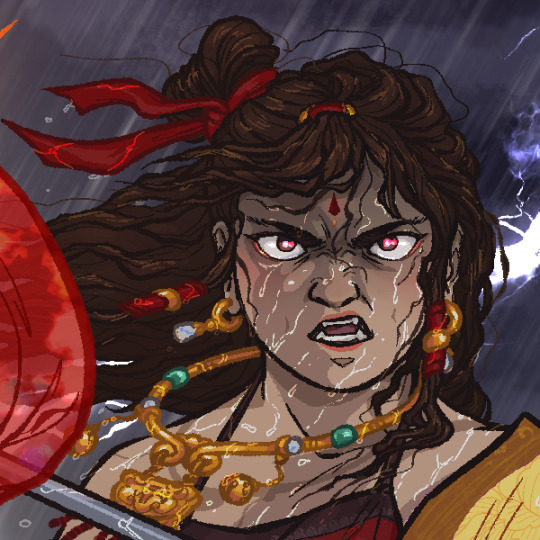

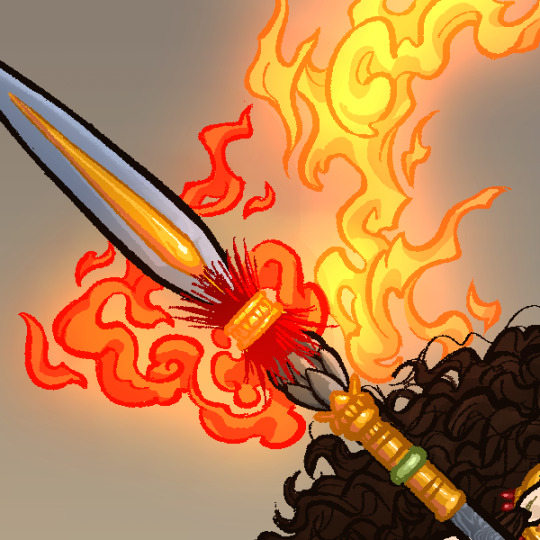

since I'm on a Nezha streak, might as well do my design for him on the Expedition AU! given that i've chosen to give characters a closer likeness to their region, it's only fitting i do the same with import deities like Guanyin, Subodhi and Nezha.
he's a complicated figure to place in the timeline because he gained popularity as a deity much after, only really arriving in China by the time the Journey would have been set. FSYY was written closer to when JTTW was written down, and he was retroactively inserted on the Zhou Dynasty period.
so deciding what to even do with him is dicey. but then i said fuck it, mythological rules apply here, he was around for the events of FSYY, and it and JTTW are set in the same universe. and for the sake of having some fun, i decided to get funky with his concept.
Nezha had the likeness of his family when he was alive, as described in FSYY, but once he was reborn with a lotus body he gained Indian traits instead. this is to be a nod to his status as an import deity and his origin as Nalakubara, and as the centuries roll by he may present himself to mortals closer to the locals' appearance wise.
as for his looks, i drew inspiration from multiple sources. read more for my rambles <3
his armor is closer to reconstructions of Zhou dynasty-period armor, skipping over extra parts simply because his lotus body is so indestructible, there's no need for a full set;
there are two red Chinese knots with jade beads dangling from the armor ties. they are said to ward off evil spirits, which felt like a good fit for a guy known to banish demons. i picked a six-petal flower pattern, which represents reunion, unity and a bright future;
i included lotus petals and leaves on his outfit as they are common in Beijing Opera outfits for him, and his makeup is a call to it as well;
The pink from the cheeks and eyeshadow seeps into his ear shell, as to convey the way sometimes, you get so angry even your ears blush;
Another thing i referenced from Opera is the two red ribbons on his sidelocks, though I changed them to two bulbs of lotus roots;
Four petals drawn close to his urna as both to make it look like a lotus but also form five petals, which is an auspicious number;
His hair crown is a fancy princely [knot] with a lotus motif and a pearl in the center, as he was the Pearl Spirit before becoming Nezha;
I was going to go with elf-like ears but I thought I could do better, so I went for stretched earlobes instead. you can't see it that well but hopefully the very large golden earrings imply it well enough xvx;
His cheek dimples are common sight on religious images of him and it was a cute touch imo;
Younger Nezha wears a golden robe because of his title as General of the Central Altar in Daoist belief, and the center direction is connected to yellow or gold, and yellow robes are usually meant for emperors and their sons, which is a minor nod to his self-assureness and boldness;
The Cosmic Ring has spiralling grooves on it both to catch blades on it for defense but also as a callback to Opera props;
On his waist is the embroidered ball weapon he was attributed with in earlier myths, he was also meant to have the leopard skin bag Taiyi Zhenren gave him, bjt it was going to be obscured by the text so i omitted it;
A few depictions of him gave him a halo of fire, which was real cool so i added it as well.
#fengshen yanyi#investiture of the gods#fsyy#iotg#li nezha#nezha#third lotus prince#third prince nezha#expedition to the west au#bell dragon art
327 notes
·
View notes
Note
A great deal of information on Nezha was never localized into English, however there is solid artistic and literary evidence that he enjoys both a child and adult form. Nezha originally was an adult, an import from India named Nalakubara. As Nalakubara, a warring mischievous sexual deity, Nezha would enter China 400 years before Tang Sanzang brought the Tripitakas to China. This format is very limiting, but I am happy to include these images if it suits you to receive visual evidence of this at the moment.








WOah- I am learning a lot about Nezha these past few hours: Neat!
Would you happen to have any textbooks/papers that go into depth about this? :D
#swagginasks#im getting a bunch of knowledge these past couple of hours in my ask box#genuinely i enjoy the discussion!#nezha discourse asks
89 notes
·
View notes
Note
hello everyone, i'm Sparrow over on patreon, LOVING the work you guys are doing!! :D
i've been meaning to ask, do you have any of the sources you guys used when doing the short timeline about Nezha and Heavenly King Li on Production Notes #4? Me and a friend are looking into the evolution of Nalakubara, and maybe those can help us! (it's okay if they aren't in English)
Thanks for the question!
Our main reference for this part of the script is a video by Professor Yu Gengzhe from Shaanxi Normal University which he mainly talked about the origin of the mythical character Li Jing and he naturally brought up Ne Zha towards the end.
【鉴定42】唐朝战神李靖是如何托上塔的?哪吒他爹居然是这么诞生的!_哔哩哔哩_bilibili
He's one of my favorite historians (watched all his CCTV lectures, bought his books etc) and Sui/Tang Dynasty is very much his expertise. In the video, he provided several written sources that trace the evolution of the figures, plus some physical relics as evidence. Hope they can be helpful for your research.
His videos are aimed at the general public so they are easy to understand and doesn't burden you with too much academic details. Our production notes are produced on a similar principle, assuming that our audience has little to no knowledge of Chinese culture. So for a lot of topics, we simply touch the surface and don't dig too deep. Which is why you are always welcome to let us know if you want to move further on the topics!
10 notes
·
View notes
Photo

Hindu Mythology & Deities
- Hindu deities (31)-
Nezha (Nalakubara)
In Buddhism, Nakrabala is a Nezha. Nezha is a protection deity in Chinese folk religion and a boy god revered in Taoism. He was then given the title "Third Lotus Prince" after he became a deity.
They wear garments shaped like lotus flowers and leaves, carry weapons such as a circular throwing weapon, a mixed-weapon twill, and a fire lance, and ride on a vehicle in the shape of two wheels, releasing fire and wind as it flies.
The figure of a man who fights on two wind and fire wheels is familiar from folk tales and novels such as "Investiture of the Gods" and "Journey to the West",and is also represented in Taoist temples in this manner.
インド神話と神様たち
−ヒンドゥー教時代からの神々(31)–
哪吒(ナクラーバラ)
仏教では、ナクラーバラは哪吒(なた)である。哪吒は、道教で崇められている少年神であり、中国の民間宗教における保護神である。神格化した後は「蓮花三太子」の称号を与えられた。
蓮の花や葉の形の衣服を身に着け、円環状の投擲武器や魔力を秘めた布、火を放つ槍などの武器を持ち、火と風を放ちながら空を飛んで戦う姿は『封神演義』『西遊記』などの民間説話や小説などでなじみ深く、道教寺院でもこのような姿で表される。
#nezha#Nalakubara#buddhism#chinese folk religion#mythology#taoist#investiture of the gods#journey to the west#Third Lotus Prince#nature#art#monkey magic
104 notes
·
View notes
Note
gonna rant real quick, i'm sorry
so i saw a post on fb, hyping ravana about not touching sita ma out of modesty
well, there's an argument to that. won't go into detail cuz you might know this one but ravana was cursed by nalakubara (son of kuber) as a result of raping his wife that his head must divide into seven pieces the moment he tries to touch a woman without consent. so when asking sita's permission for laying a hand on her, ravan was rather saving his own neck, that wasn't modesty
sorry again, just thought this might interest you cuz you're into mythology
I knew that and I'd even made a post about it.
Guys - he wasn't respecting Sita. Heck even in the Ashok Vatika in Lanka, he didn't touch her out of the same fear.
The only lady he ever respected was his girlboss wife Mandodari.
15 notes
·
View notes
Text
Krishna is tied to the mortar (5)
Krishna is tied to the mortar (5)
This particular story has two stories rolled into one. Once Kubera’s twin sons Nalakubara and Manigriva were cursed by Sage Narada (they must have done something really vile for the normally sweet tempered Narada to lose it, but that’s a different story) to be born as two Arjuna (Terminalia Arjuna) trees and spend 100 years before they would be liberated from their curse. These two incarnated as…
View On WordPress
0 notes
Text
I was chatting with @digitalagepulao about this image of Nalakubara holding Heavenly King Vaisravana’s stupa and realized that I didn’t know when the bearer of the golden stupa/pagoda shifted from Nalakubara/Nezha to Heavenly King Vaisravana/Li Jing.
My first hypothesis was that this is a change exclusive to China as Buddhism spread and continued to develop/affect Daoism. If anyone has information on this change I’m more than happy to receive it.

Tang-period drawing preserved at the Ninna Monastery in Kyoto. May also be located within Taishō shinshū daizōkyō zuzōbu, volume 7, pages 566-567.
#li nezha#nezha#li jing#vaisravana#nalakubara#four heavenly kings#journey to the west#jttw#canonization of the gods#fsyy#buddhism#daoism
24 notes
·
View notes
Text
The Inconsistency of Nezha's Age, a Short Introduction.
Put very bluntly, Nezha’s age varies greatly depending on which story you’re reading and who’s retold it. He is not always a child or an adult depending on retelling, though my intention here is to highlight the sheer variety available first and foremost - and perhaps shine a light on the Indian dieties which may have influenced him. If these varied images are unwanted, please keep scrolling.
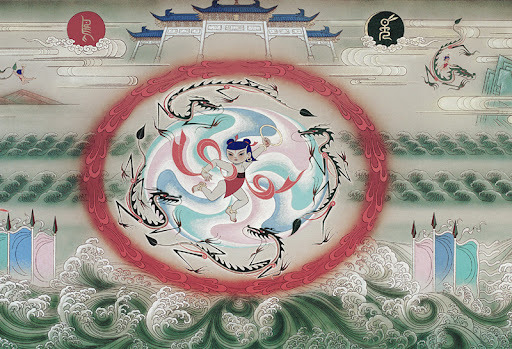
I happened to stumble upon a timeline error where Nezha’s brother Muzha is described to be using martial arts weapons referred to as “Hooks of Wu” which were specific to the 1800s, quite a long time after Canonization of the Gods was published, but also originating from a time period where numerous varied editions of that story were in circulation. Upwards of twenty different versions exclusive to the 19th century, actually.
The problem arises that Canonization of the Gods is meant to be occurring during the Zhou Shang conflict, that I will generously assume to be in 1045BCE, centuries before the Hooks of Wu would actually exist. It’s completely possible that the version Gu Zhizhong translated was one of these later editions as is makes no chronological sense for Muzha to have those kinds of weapons to begin with. So I have been on somewhat of a rabbit chase trying to pin down the edition Gu Zhizhong used.
Bearing such errors in mind, it’s easy to see where the confusion of Nezha’s age can come from. Before his origin story was integrated within Canonization of the Gods he would be roughly three to seven days old when his conflict with Ao Guang and the Lady Rock Demoness would occur - whereas within Canonization of the Gods he’s actually 6 or 7 years old.
Outside of that, a definitive age isn’t actually provided. Genuinely, within the scope of Chinese folklore and mythos it’s very rare to assign someone an exact age - which I do believe contributed heavily to the known discourse surrounding Nezha’s age to begin with.
He was imported as an adult from India, a child form not seeming to exist for a while until stories of Krsna were integrated to how the Chinese envisioned Nalakubara. Krsna, being an infantile disguise for the notorious Vishnu, also displays supernatural human strength and is actually successful in killing his father figure (1) — unlike Nezha.
As children, both Krsna and Nezha are able to wield heavenly bows and subjugate water spirits (2) while also being known to be dragon tamers (3). The inclusion of these stories to Nezha predates the sculpting of the Quanzhou Pagoda’s (which have been discussed briefly here) and are arguably the earliest evidence of Nezha being a dragon tamer.
Speculatively a child god combination of both Nalakubara and Krsna named Nana is likely where a majority of Nezha’s child attributes come from, based in the Scripture of the Supreme Secrets of Nana Deva - which would see translations within China during the Northern Song period of 960AD-1127AD. Nana would be described thus:
At that time there was a Deva called Nana. His appearance was exceptionally handsome, and his face beamed with a gentle smile. He was holding the sun, the moon, and various weapons. His numerous treasures and abundant jewelry shone more brightly than the sun and the moon. He made himself a luoye robe (4) from the dragons Nanda and Upananda, and a belt from the dragon Taksaka (5). He possessed the same strength as Narayana (i.e. Visnu). He too came to the assembly and sat down facing the Buddha … At that time the Buddha emanated great light from his dharma body of meditation. The light covered the entire Buddha Universe, reaching all the great evil yaksas, the various types of raksasas and pisacas (6) and all the evil dragons as far as the heavenly constellations. When the Buddhas light shone upon them they all awoke to the truth. The Buddhas light returned to him and, after encircling him three times, entered his head. It then reissued in seven colors from his brow, entering Nana-Deva’s head. When the Buddha light penetrated his head, Nana Deva displayed an enormous body like Mt. Sumeru. His facial expression alternated between terrifying anger and a broad smile. He had a thousand arms, and he was holding a skull (7) and numerous weapons. He was handsomely adorned with a tiger skin robe and skulls. [Mightily Strong] He emanated blazing light and terrifying strength. When Nana Deva displayed this divine body, the great earth shook, and all who beheld him were terrified.
Both Nana and Nezha share the same residence of Vaisravana’s palace, are known dragon tamers, and both were known to use belts. The Supreme Secrets of Nana Deva predate all known connections between Nezha and dragons, perhaps lending to Nezha many more elements than initially believed.
Though without concrete evidence stating one way or another, I can only present this information speculatively - especially as it seems difficult for some to understand that Nezha does enjoy a known adult and child form. This answer has already become quite long, so if there’s still confusion regarding this please feel free to ask for more details.
Bibliography:
(1) Goldman, “Fathers, Sons and Gurus,” pp.350, 364; Masson, “Childhood of Krsna”; Ramanujan, “The Indian ‘Oedipus’”; Silk, Riven by Lust, pp. 164-170.
(2) Harley, “Krishna’s Cosmic Victories”; Matchett, “Taming of Kaliya”.
(3) It’s worth comparing Matchett’s “Taming of Kaliya” p.116 with Canonization of the Gods 12.103. Nezha is five days old within the Ming era Sanjiao yuanliu shengdi fozu sou shen daquan, p. 326.
(4) Luoye is the Chinese term for a garment Indian men tied under the armpit, leaving their right shoulder bare. See Xuanzang, Da Tang Xiyu ji, T. 2087, 51: 876b, and Li Rongxi’s translation, Great Tang Dynasty Record, p.53.
(5) Nanda, Upananda, and Taksaka appear in various Buddhist lists of the eight dragon kings; see Foguang da cidian, pp. 6378,6405.
(6) The rakasas and pisacas are two types of Hindu ogres, who Buddhists demonology incorporated. Both types feed on human flesh. See Foguang da cidian, pp6673-6674 and 3851; Monier-Williams, A Sanskrit-English dictionary, pp. 871 and 628; and Strickman’s survey of Buddhist demonology in his Chinese Magical Medicine, pp. 62-68.
(7) Geboluo appears frequently within the contemporaneous Chinese translation of the Hevajra Tantra (Foshuo dabeikong zhi jin’guang dajiaowang yigui jing), no. 892 volume 18: 587-601.
(8) Zuishang mimi Nana tian jing, no. 1288, 21:358b-c. hi
#nezha#li nezha#lmk nezha#monkie kid nezha#the legend of nezha#nezha 2019#nezha reborn#nezha lego monkie kid#third lotus prince#lego monkie kid
197 notes
·
View notes
Note
From what I understand, your advice is that we shouldn't stick to just one version of a story or consider it the true version. And that a story has several versions. And these versions do not make one less than the other. Like, we can choose one version of the story as long as we understand that there are more versions.
Hello!
Yes this is precisely it. It’s very easy to assume that one way a story is told is the only valid version, but it also neglects how it historically was shared and retold - regardless of if deities are involved. Of course people are allowed to express favoritism, myself having moved from Wuhan, I prefer Wuhanese storytelling.
Did you know there’s roughly 360 different types of regional Chinese Opera that coexist? And with such a large variation in a specific area of performing arts, there’s bound to be more variation in nearly anything else.
Myself and the study of Nezha/Nalakubara has led me down many many different rabbit holes into how he was spread across east and southeast Asia. He appears in India, China, Taiwan, Macau, Hong Kong, Japan, Korea, Malaysia, Singapore, Thailand, Kazakhstan, Tibet, and very likely many other places I have yet to know. It would be very ignorant of me to assume the Chinese Daoist method of worship to be the only acceptable kind - and downright shameful to dismiss how other countries worship him.
It’s a lengthy answer, but I hope I was able to convey my feelings and personal thoughts properly.


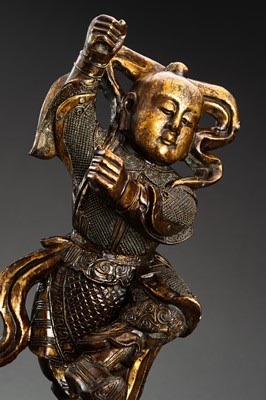
#nezha#li nezha#lmk nezha#monkie kid nezha#nezha 2019#the legend of nezha#nezha reborn#nezha lego monkie kid#third lotus prince#chinese religion#chinese mythology#chinese folklore#chinese literature#chinese opera#chinese culture#chinese dance#chinese history
61 notes
·
View notes
Note
I thank you for answering my previous question! (I'm so glad there are people on social media who work together to share knowledge like this!)
One of things I guess I did get confused with in my research is Nezha's origin story. It does help that you clarified about the many versions being different but they all are a part of telling the story. I overheard a rumor that there was an official book that told the "original" version of his story, but that is what my research is mainly trying to solve. I see a few titles saying they talk about Nezha's backstory, but none that claimed to be original. So I suppose I could be wrong in what I heard. Again, I thank you fir answering my questions! It's been fun learning new things about these topics!
Hello Hello!
I see, I understand what you’re trying to get here. To the best of my knowledge the earliest version of Nezha’s origin myth comes from The Grand Compendium of the Three Religion’s Deities. There is an edition from the Ming Dynasty (1368AD-1644AD) and an edition from the Qing Dynasty (1636AD–1911AD), but both editions cover roughly the same information and the distinction isn’t necessary here.
When he was five days old, Nezha went bathing in the Eastern Ocean. He trampled over the [dragon king's] Crystal Palace. He somersaulted straight to the top of the Precious Pagoda. Because he had trampled over his palace, the infuriated dragon king challenged him to fight. By then, Nezha was already seven days old, and he could overcome the nine dragons. The old dragon had no choice, except complaining to the [Jade] Emperor. The General [Nezha] knew of his intention. Intercepting him by Heaven's Gate, he killed the dragon. Mounting the Jade Emperor's altar, Nezha took the Buddha's bow and arrows. He shot an arrow, unintentionally killing Lady Rock's son. Lady Rock raised an army to fight him. The General [Nezha] took the Demon-Felling Club from his father's altar and, fighting his way Westwards, slew her. Considering that Lady Rock had been the demons' chief, Nezha's father was infuriated. He worried lest his son's killing her would provoke the demon hordes to war. Therefore, the General [Nezha] sliced off his flesh and bones, returning them to his father. Holding fast to his inner soul (zhen ling), he hastened to the Buddha's side, pleading that the World-Honored One make him complete once more. Considering that Nezha could subdue demons, the Buddha snapped a lotus flower. He fashioned it's stem into bones, it's roots into flesh, it's fiber into tendons, and it's leaves into clothes, giving life to Nezha once more.
I do hope this was helpful in your search. It’s entirely possible this story was imported from India during the Tang Dynasty (618AD-907AD) or Song Dynasty (960AD-1279AD) or even as early as the Wei Dynasty (386AD-535AD)
A majority of literature about Nezha was written during the Tang Dynasty (618AD-907AD) which was followed by one (of many) instances where China was no longer unified in a warring states period. It would be (705AD-960AD) where China was not unified and no further literature about Nezha was either written or survived.
Nezha had of course existed before the 7th century, but in terms of a timeframe Nezha and any written record of him was brought to China some centuries before Tang Sanzang went to India. Figure he formally entered China around 266AD-420AD while Sanzang left for India around 629AD.
It is wholly possible a story like this existed while Nezha was still Nalakubara, third son of the Heavenly King Vaisravana. I’ve yet to locate anything like that yet but this post will be amended to reflect if new information has been found.
#li nezha#nezha#lmk nezha#monkie kid nezha#nezha 2019#nezha reborn#the legend of nezha#dislyte nezha#nezha lego monkie kid#third lotus prince
42 notes
·
View notes
Note
so I've got a question for ya
more LMK specific but since you're well versed in knowledge about him, thought I'd ask
I'm curious on your opinion of the (LMK) Nezha "shipping"?
everyone's weird about it bc of most of his interpretations being eternally 12, and y'know, I've got a neutral opinion- I don't really care if people do because immortals have really fucking weird relationships/demonstrations of age due to being very much NOT mortal, and it's a completely different interpretation, and it also HEAVILY depends on the context, so I'm just kind of all "shrug. do what you wanna do"
but I'm simply curious about what you view from it. :D
So I’ve sat on this for a while because I didn’t know how to properly articulate what I wanted to say. I still don’t wholly know, but I will do my best.
I do not personally care if someone does or does not ship Nezha with others, it is common practice within Chinese social media circles to ship and make fanart of these deities together as it is mostly harmless fun.
Nezha is not an eternal child and has never once stated to be one within his original mythos, documentation of him in derivative works, or in the ways he is portrayed in statues. This is not to deny the existence of a child Nezha as he too has his purpose, but things like his associations with lotus motifs and a number of his weapons are specific to when Canonization of the Gods was widely circulated. This is a topic itself that I have been sitting on but want to properly debunk in the future.
I understand the misunderstandings though. A great deal of information about Nezha was never properly localized into English, and the English language media available of him largely presents him as a child. This is not an excuse for remaining ignorant and claiming to have done research you did not do, as I have seen many defensive and angry fans do.
Additionally, I don’t know where the 12 number comes from. I could not find an example predating 2015 that states this, the only example I could find being Overly Sarcastic Productions’ series covering Journey to the West which is littered with various errors and should not be heralded as 100% factual. If anyone is able to locate an example predating 2015 I will be happy to receive it. I have been trying to find the root of this specific misinformation for a while.
It would be disingenuous to pretend that Nezha/Nalakubara did not undergo some form of change in the centuries he has existed and been worshipped. However it must be acknowledged that both his child and adult self hold important functions in terms of deific worship.
At the time of this answer being written I am currently researching Nezha’s extensive military career as well as his birthday celebrations during the month of April.
To wrap this up I will attach various images of non-child Nezhas. I will not further elaborate on this until I am ready.
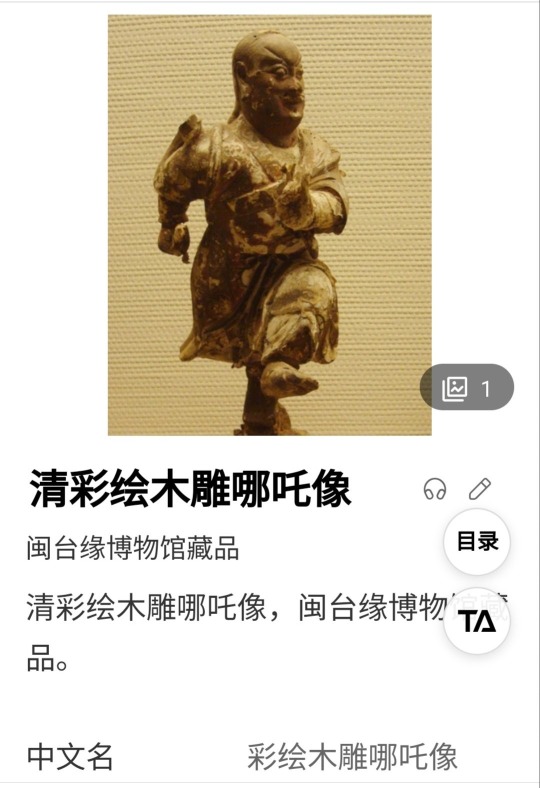
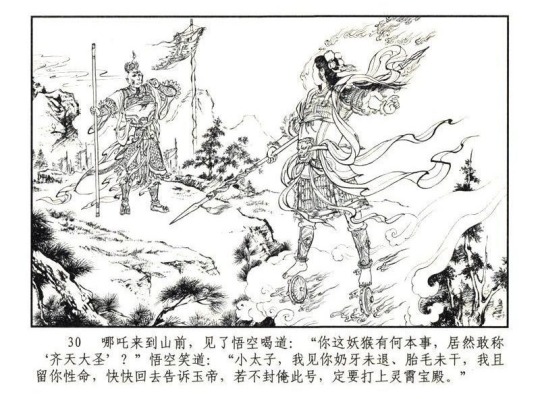
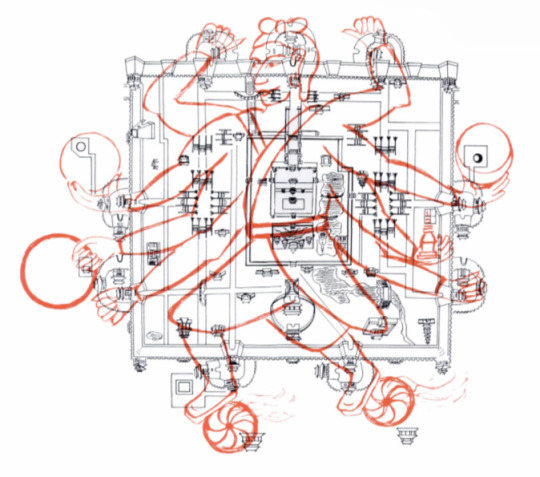



#li nezha#lmk nezha#nezha#nezha 2019#nezha reborn#the legend of nezha#dislyte nezha#monkie kid nezha#lego monkie kid
100 notes
·
View notes
Note
Hello! I've become interested in learning the lore of Nezha, trying to find the definitive version of it. My research had become complicated as a lot of places I turn to leads me to a different version of it. Do you know where I could possibly look for the original version of the story?
Hello hello!
I see my good friend Pilgrim Sun has sent you my way. While I do commend you for your own research efforts on this it’s very important to understand that when handling deities, religious figures, and even recorded folklore, there is no one singular definitive ‘canon’ as these stories and deities’ identities change and fluctuate. And for a deity that has been around for centuries upon centuries, the development of Nezha/Nalakubara is incredibly non-linear.
Every story or “different version” you had encountered is valid in it’s own way. The stories and deities change to fit the needs and interests of the common people, and the sheer volume of different written records of roughly the same stories is a testament to the people circulating it — this of course barring the many centuries these stories or tales of grand deities were only circulated by spoken word.
And of these editions even being translated out of Chinese, it isn’t many. I’m actually in the process of trying to translate a whole Kunqu (martial arts) opera featuring both Nezha and Er’lang Shen; and I can see why so much Nezha related literature was left un-translated for the sheer difficulty of it alone.
However it is also completely possible that I misunderstood your question, and if I had, you are more than welcome to send another ask or message to clarify certain details.
#li nezha#nezha#lmk nezha#monkie kid nezha#nezha 2019#nezha reborn#the legend of nezha#dislyte nezha#nezha lego monkie kid#third lotus prince
22 notes
·
View notes
Note
I saw someone once say nezha is also a god of war is it true?
Hello Hello!
This is in large part very true and has held true for a majority of how long Nezha has existed, until about when Canonization of the Gods was widely circulated.
Nezha, as Nalakubara before he was imported to China, was a trickster warring deity with sexual tendencies. A great deal of his warring identity was brought with him to China, and stories detailing how Nezha slaughtered battlefields weren’t uncommon. Nezha’s name was even invoked as a compliment for someone’s militaristic ability.
I do plan to make a longer form post explaining his identity as a war deity, so this is only scratching the surface. Thank you for your question!
#li nezha#lmk nezha#nezha#dislyte nezha#monkie kid nezha#nezha 2019#nezha reborn#the legend of nezha
37 notes
·
View notes
Photo


Hindu Mythology & Deities
- Hindu deities (30)-
Yakshas / Nalakubara
Nalakūbara is the Deva, Gandharva or Yaksha, who appears in Hindu and Buddhist mythology as the brother of Manibhadra, the son of Kubera, King of Yaksha, and the husband of Ramba.
Nalakubara and the sons of Kubera, the god of treasure, who lived on Mt. Kailas, were the consort of Rudra and blessed with status and wealth, and lived a life of luxury and drunkenness.
In the Bhagavata Purana, one day, two brothers were drunk and rude to the holy sage Narada who was passing by. On the occasion, Nārada, lamenting their attitude, put a curse on them to transform themselves into Arjuna's twin trees and left with a prophecy that the curse would be lifted after a hundred years of God. As they were stuck, they regretted their previous wrongdoing.
Many years later, the young Krishna stole the butter and was nailed to the mortar by his mother. Undeterred, Krishna dragged the mortar through the twin trees in question. The trees could not withstand Krishna's monstrous power and they came loose from their roots. This lifted the curse and Narakubala and Manigliva emerged with a halo, and they both rejoiced at having met Krishna and took refuge in Vishnu.
インド神話と神様たち
−ヒンドゥー教時代からの神々(30)–
夜叉・ナラクーバラ
ナラクーバラは、マーナグリヴァの兄、ヤクシャ王クベラの息子でランバの夫として、ヒンドゥー教と仏教の神話に登場するデーヴァ、ガンダルヴァまたはヤクシャである。
カイラス山に住む財宝の神クベーラの子であるナラクーバラとマニグリーヴァは、ルドラの眷属であり、地位と財産に恵まれていたため、贅を尽くし、酒色に溺れる生活を送っていた。
『バーガヴァタ・プラーナ』によると、ある日、酔っ払った二人の兄弟は通りかかった聖仙ナーラダに無礼を働いてしまった。その際、彼らの態度を嘆いたナーラダは、彼らにアルジュナの双子の木に変身する呪いをかけ、「神の百年後に呪いが解ける」という予言を残して去っていった。動けなくなった彼らは、それまでの悪行を悔やんだ。
数年後、幼いクリシュナはバターを盗んだため、母により臼にくくりつけられてしまった。それをものともせずに、クリシュナは臼を引きずって歩き、双生樹の間を通った。木はクリシュナの怪力に耐えきれず2本とも根元から抜けてしまった。これにより呪いが解けて、ナラクーバラとマニグリーヴァは後光とともに出現し、二人はクリシュナに出会えた事を喜ぶと共に、ヴィシュヌに帰依した。
54 notes
·
View notes